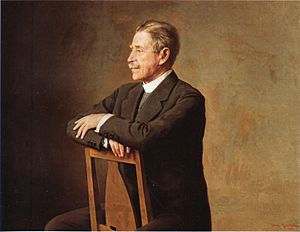Verner von Heidenstam facts for kids
Quick facts for kids
Verner von Heidenstam
|
|
|---|---|

Portrait by Johan Krouthén, 1931
|
|
| Born | Carl Gustaf Verner von Heidenstam 6 July 1859 Olshammar, Örebro County, Sweden |
| Died | 20 May 1940 (aged 80) Övralid, Östergötland, Sweden |
| Occupation | Poet, novelist |
| Nationality | Swedish |
| Notable awards | Nobel Prize in Literature 1916 |
| Spouse | Emilia Uggla (m. 1880, d. 1893); Olga Wiberg (m. 1893, div.); Greta Sjöberg (m. 1900, div.) |
| Relatives | Gustaf von Heidenstam (father) |
Carl Gustaf Verner von Heidenstam (born July 6, 1859 – died May 20, 1940) was a famous Swedish writer. He was a poet and novelist. In 1916, he won the Nobel Prize in Literature.
Heidenstam became a member of the Swedish Academy in 1912. This is a group that works to improve the Swedish language and literature. His writings often showed a great love for life. They also shared his passion for Swedish history and its beautiful landscapes.
Contents
About Verner von Heidenstam
Early Life and Travels
Verner von Heidenstam was born in Olshammar, Örebro County, Sweden. This was on July 6, 1859. He came from a noble family.
He first studied painting at the Royal Swedish Academy of Fine Arts in Stockholm. But he soon left because he was not well. After that, he traveled a lot. He visited many places in Europe, Africa, and the Middle East.
Becoming a Writer
Heidenstam became known as a promising poet very quickly. This happened when he published his first collection of poems. It was called Vallfart och vandringsår (Pilgrimage: the Wander Years) in 1888.
These poems were inspired by his travels in the Middle East. They also showed a new style of writing. It was different from the naturalism that was popular in Swedish literature at the time.
Famous Works and Themes
Heidenstam loved beauty, and this showed in his long poem Hans Alienus (1892). His book Dikter ("Poems", 1895) was also very popular.
He wrote Karolinerna (The Charles Men, 1897–1898). This book had historical stories about King Charles XII of Sweden and his soldiers. It showed his strong national pride.
Another important work was Folkunga Trädet (The Tree of the Folkungs). This was a two-volume epic story (1905–07). It told the inspiring tale of a family of Swedish leaders from the Middle Ages.
In 1915, Heidenstam published a collection of poems called Nya Dikter. These poems explored deep ideas about life. They often focused on how people can become better and rise above loneliness.
Later Life and Legacy
Verner von Heidenstam passed away at his home, Övralid, on May 20, 1940. He is remembered as one of Sweden's most important writers. His works continue to be read and enjoyed.
Works by Verner von Heidenstam
- Från Col di Tenda till Blocksberg (1888) – Travel stories
- Vallfart och vandringsår (1888) – Poems
- Renässans (1889)
- Endymion (1889) – A novel
- Hans Alienus (1892) – A long poem
- Dikter (1895) – Poems
- Karolinerna (The Charles Men, 1897–98) – A novel
- Sankt Göran och draken (1900)
- Heliga Birgittas pilgrimsfärd (Saint Bridget's Pilgrimage, 1901)
- Ett folk (1902)
- Skogen susar (The Forest Whispers, 1904)
- Folkungaträdet (The Tree of the Folkungs, 2 volumes, 1905–1907)
- Svenskarna och deras hövdingar (1910) – Historical lectures
- Nya Dikter (1915) – Poems
Works Translated into English
- A King and his Campaigners (1902)
- The Soothsayer (1919)
- Sweden's Laureate. Selected Poems of Verner Von Heidenstam (1919) – Translated by Charles Wharton Stork
- The Birth of God (1920)
- The Charles Men (1920) – Translated by Charles Wharton Stork
- The Swedes and their Chieftains (1925) – Translated by Charles Wharton Stork
- The Tree of the Folkungs (1925)
See also
 In Spanish: Verner von Heidenstam para niños
In Spanish: Verner von Heidenstam para niños


